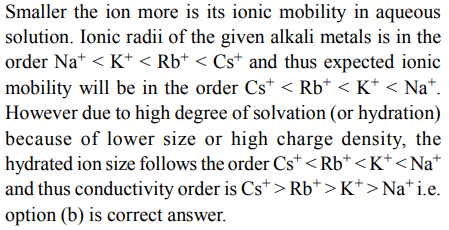1. Nitrogen dioxide cannot be prepared by heating
a) \[KNO_{3}\]
b) \[Pb\left(NO_{3}\right)_{2}\]
c) \[Cu\left(NO_{3}\right)_{2}\]
d) \[AgNO_{3}\]
Explanation: Only nitrates of heavy metals and lithium decompose on heating to produece NO2
2. When NaCl is dissolved in water, the Na+ ions are
a) hydrated
b) hydrolysed
c) oxidised
d) reduced
Explanation: hydrated
3. Which one of the following properties of alkali metals increases in magnitude as the atomic number rises ?
a) Ionic radius
b) Melting point
c) Electronegativity
d) First ionization energy
Explanation: Within a group, ionic radius increases with increase in atomic number. The melting points decrease down the group due to weakning of metallic bond. The electronegativity and the 1st ionization energy also decreases down the group
4. Which of the following is known as fusion mixture?
a) Mixture of \[Na_{2}CO_{3}+NaHCO_{3}\]
b) \[Na_{2}CO_{3}.10H_{2}O\]
c) Mixture of \[K_{2}CO_{3}+Na_{2}CO_{3}\]
d) \[NaHCO_{3}\]
Explanation: Mixture of K2CO3 and Na2CO3 is called fusion mixture
5. Sodium is made by the electrolysis of a molten mixture of about 40% NaCl and 60% \[CaCl_{2}\] because
a) \[Ca^{++}\] can reduce NaCl to Na
b) \[Ca^{++}\] can displace Na from NaCl
c) \[CaCl_{2}\] helps in conduction of electricity
d) this mixture has a lower melting point than NaCl
Explanation: Sodium is obtained by electrolytic reduction of its chloride. Melting point of chloride of sodium is high (803°C) so in order to lower its melting point(600°C), calcium chloride is added to it
6. Aqueous solution of sodium carbonate absorbs NO and \[NO_{2}\] to give
a) \[CO_{2}+NaNO_{3}\]
b) \[CO_{2}+NaNO_{2}\]
c) \[NaNO_{2}+CO\]
d) \[NaNO_{3}+CO\]
Explanation:

7. In crystals of which one of the following ionic compounds would you expect maximum distance between centres of cations and anions?
a) LiF
b) CsF
c) CsI
d) LiI
Explanation: As Cs+ ion has larger size than Li+ and I– has larger size than F– , therefore maximum distance between centres of cations and anions is in CsI
8. In which of the following processes, fused sodium hydroxide is electrolysed at a 330ºC temperature for extraction of sodium?
a) Castner's process
b) Down's process
c) Cyanide process
d) Both (b) and (c)
Explanation: In Castner process, for production of (Na) Sodium metal, Sodium hydroxide (NaOH) is electrolysed at temperature 330ºC
9. The sequence of ionic mobility in aqueous solution is :
a) \[K^{+}>Na^{+}>Rb^{+}>Cs^{+}\]
b) \[Cs^{+}>Rb^{+}>K^{+}>Na^{+}\]
c) \[Rb^{+}>K^{+}>Cs^{+}>Na^{+}\]
d) \[Na^{+}>K^{+}>Rb^{+}>Cs^{+}\]
Explanation:

10. The alkali metals form salt-like hydrides by the direct synthesis at elevated temperature. The thermal stability of these hydrides decreases in which of the following orders ?
a) CsH > RbH > KH > NaH > LiH
b) KH > NaH > LiH > CsH > RbH
c) NaH > LiH > KH > RbH > CsH
d) LiH > NaH > KH > RbH > CsH
Explanation: The stability of alkali metal hydrides decreases from Li to Cs. It is due to the fact that M–H bonds become weaker with increase in size of alkali metals as we move down the group from Li to Cs. Thus the order of stability of hydrides is LiH > NaH > KH > RbH > CsH